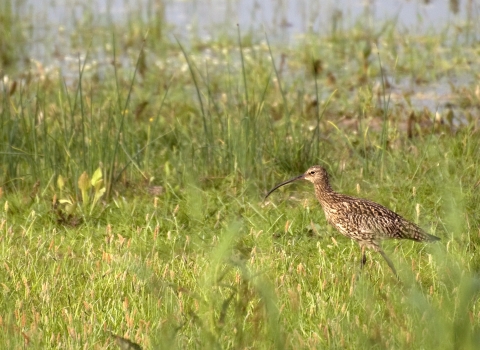Lowland wet grassland is one of the most important habitats in the Severn Vale
Inevitably increasing demand for food production has resulted in drainage of this valuable habitat over the decades.
We hope that by using the Living Landscape approach in the Severn Vale, that we will be able to start balancing agriculture and conservation to the benefit of both people and wildlife.
We have been working in Gloucestershire's Severn Vale since 2007 on ambitious plans to restore good quality wildlife habitat. The team is working with landowners and communities on restoration of lowland wet grassland and other wetland habitats which are so important for breeding waders and wintering ducks.
What we are doing
In the Severn Vale the long term aim is to restore up to 60% of the area to good quality wetland and semi-improved wildlife habitat.
The project area spreads across 11,000 hectares, and is split into 22 'Strategic Nature Areas' (SNAs).
An example of what we are doing can be seen above where the different stages of creating a scrape can be seen ( A scrape is a shallow pond with gently sloping edges).
A scrape provides a great environment for wading birds to feed their chicks and scrapes support many forms of wildlife that wading bids feed on.
How we work to restore and manage the landscape:
- We work with farmers and landowners to provide advice, assist with access to funding, and develop ways to make conservation and farming economically sustainable.
- We do a significant amount of partnership working to develop strategies and projects with bodies such as the Environment Agency, Lower Severn Internal Drainage Board, British Waterways, and Natural England.
- We work with communities and volunteers to monitor species and enhance their local environment.
What we've achieved
We have achieved some fantastic results and the team has been instrumental in the design and delivery of many conservation projects throughout the wider countryside of the Severn Vale
The aim of the work has been to connect and expand areas of good habitat for target species that are found in or associated with wetlands.
We want to create a dynamic environment for wildlife to counteract the unknown impacts associated with climate change.

Curlew by Zsusanna Bird
Target Habitats and Species
The target habitat for restoration and creation in the Severn Vale is lowland wet grassland.
This includes other wetland habitats such as unimproved neutral grassland, fen and marsh, reedbed, wet woodland and saltmarsh.
Many species depend on these habitats, and we are focussing on nationally and locally threatened species. To help these species and habitats we undertake a variety of work.
Key achievements in the first five years of our work include:
• 319 hectares of wet grassland being maintained and restored for the benefit or over-wintering wildfowl and breeding wading birds
• 22.5km of fencing installed to enable the management and protection of key wildlife habitats and species
• 2km of hedgerows restored and 59km in favourable management
• 31 farmland ponds fully restored
• 8 scrapes totalling 9000m2 of open standing water created
• 98.48 hectares of species rich meadows being maintained and restored through favourable management
• 622 willows pollarded
• 17.72 hectares of traditional orchards being maintained and restored through favourable management
• Approximately 1,700 hectares of farm land submitted into environmental stewardship schemes
• £2,862,861.76 secured via Environmental Stewardship
• More than 120 volunteers involved in the project (brown hare surveys, otter surveys, otter holt construction and control of Himalayan balsam)
• 59 landowners engaged
